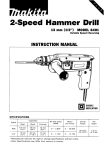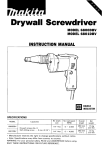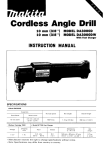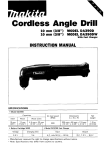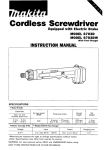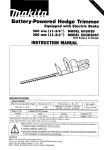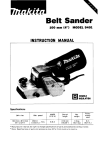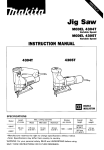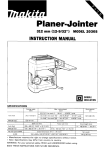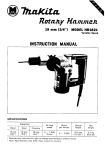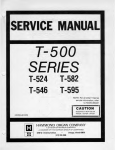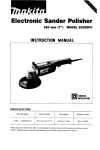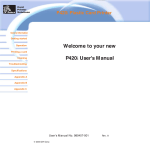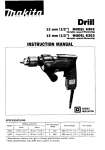Download Makita 9300 Instruction manual
Transcript
Bench Grinder 125 mm (5") MODEL 9300 INSTRUCTION MANUAL SPECIFICATI0 NS Wheel size 1 Hz 1 No load speed 1 Overall length * Manufacturer reserves the right t o change specifications without notice. Note: Specifications may differ from country t o country. I Net weight For Your Own Safety Read Instruction Manual Before Operating BENCH GRINDER I GENERAL SAFETY PRECAUTIONS (For All Tools) 1. KNOW YOUR POWER TOOL. Read the owner's manual carefully. Learn the tools applications and limitations, as well as the specific potential hazards peculiar t o it. 2. KEEP GUARDS IN PLACE and in working order. 3. REMOVE ADJUSTING KEYS AND WRENCHES. Form habit of checking to see that keys and adjusting wrenches are removed from tool before turning it on. 4. KEEP WORK AREA CLEAN. Cluttered areas and benches invite accidents. 5. DON'T USE IN DANGEROUS ENVIRONMENT. Don't use power tools in damp or wet locations, or expose them t o rain. Keep work area well lighted. 6. KEEP CHILDREN AWAY. All visitors should be kept safe distance from work area. 7. MAKE WORKSHOP KID PROOF with padlocks, master switches, or by removing starter keys. 8. DON'T FORCE TOOL. It will do the job better and safer at the rate for which it was designed. 9. USE RIGHT TOOL. Don't force tool or attachment t o do a job for which it was not designed. 10. WEAR PROPER APPAREL. Wear no loose clothing, gloves, neckties, rings, bracelets, or other jewelry which may get caught in moving parts. Nonslip footwear is recommended. Wear protective hair covering t o contain long hair. 11. ALWAYS USE SAFETY GLASSES. Also use face or dust mask if cutting operation is dusty. Everyday eyeglasses only have impact resistant lenses, they are NOT safety glasses. 12. SECURE WORK. Use clamps or a vise to hold work when practical. It's safer than using your hand and it frees both hands t o operate tool. 13. DON'T OVERREACH. Keep proper footing and balance at all times. 14. MAINTAIN TOOLS WITH CARE. Keep tools sharp and clean for best and safest performance. Follow instructions for lubricating and changing accessories. 15. DISCONNECT TOOLS before servicing; when changing accessories such as blades, bits, cutters, and the like. 16. REDUCE THE RISK OF UNINTENTIONAL STARTING. Make sure switch is in off position before plugging in. 2 17. USE RECOMMENDED ACCESSORIES. Consult the owner's manual for recommended accessories. The use of improper accessories may cause risk of injury t o persons. 18. NEVER STAND ON TOOL. Serious injury could occur if the tool is tipped or if the cutting tool is accidentally contacted. 19. CHECK DAMAGED PARTS. Before further use of the tool, a guard or other part that is damaged should be carefully checked t o determine that it will operate properly and perform its intended function - check for alignment of moving parts, binding of moving parts, breakage of parts, mounting, and any other conditions that may affect its operation. A guard or other part that is damaged should be properly repaired or replaced. 20. DIRECTION OF FEED. Feed work into a blade or cutter against the direction of rotation of the blade or cutter only. 21. NEVER LEAVE TOOL RUNNING UNATTENDED. TURN POWER OFF. Don't leave tool until it comes t o a complete stop. 22. PROPER GROUNDING. This tool should be grounded while in use to protect the operator from electric shock. 23. EXTENSION CORDS: Use only three-wire extension cords which have threeprong grounding-type plugs and three-pole receptacles which accept the tool's plug. Replace or repair damaged or worn cord immediately. VOLTAGE WARNING: Before connecting the tool t o a power source (receptacle, outlet, etc.) be sure the voltage supplied is the same as that specified on the nameplate of the tool. A power source with voltage greater than that specified for the tool can result in SERIOUS INJURY t o the user - as well as damage to the tool. If in doubt, DO NOT PLUG IN THE TOOL. Using a power source with voltage less than the nameplate rating is harmful t o the motor. 3 GROUNDING INSTRUCTIONS ALL GROUNDED, CORD-CONNECTED TOOLS: In the event of a malfunction or breakdown, grounding provides a path of least resistance for electric current t o reduce the risk of electric shock. This tool is equipped with an electric cord having an equipment-grounding conductor and a grounding plug. The plug must be plugged into a matching outlet that is properly installed and grounded in accordance with all local codes and ordinances. Do not modify the plug provided - if it will not fit the outlet, have the proper outlet installed by a qualified electrician. Improper connection of the equipment-grounding conductor can result in a risk of electric shock. The conductor with insulation having an outer surface that is green with or without yellow stripes is the equipment-grounding conductor. If repair or replacement of the electric cord or plug is necessary, do not connect the equipment-grounding conductor t o a live terminal. Check with a qualified electrician or serviceman if the grounding instructions are not completely understood, or if in doubt as t o whether the tool is properly grounded. Grounded, cord-connected tools intended for use on a supply circuit having a nominal rating less than 150 volts: This tool is intended for use on a circuit that has an outlet that looks like the one illustrated in Figure A. The tool has a grounding plug that looks like the plug illustrated in Figure A. A Temporary adapter, which looks like the adapter illustrated in Figure B and C, may be used t o connect this plug to a 2-pole receptacle as shown in Figure 6 if a properly grounded outlet is not available. The temporary adapter should be used only until a properly grounded outlet can be installed by a qualified electrician. The green-colored rigid ear, lug, etc. extending from the adapter must be connected t o a permanent ground such as a properly grounded outlet box. GROUNDING METHODS FIG. 6 FIG. A 9 1 Grounding Pin -Cover of GroundedOutlet Box - FIG. C Adapter 9 Grounding Means 4 ADDITIONAL SAFETY RULES FOR BENCH GRINDER 1. Be sure that the guards are in place t o protect the operator against flying debris and injury in case the wheel breaks. 2. Check the wheel for cracks and chipped edges before mounting and/or running it. Stand away from the front of the wheel and run for more than one minute t o test it. Replace if you note anything abnormal. Then test new wheel for more than 3 minutes. 3. Use only the face of a straight wheel and the side of a cup wheel when grinding. Avoid sudden feeds of work into wheel t o minimize the possibility of cracks or breakage. 4. Do not strike or drop the wheel. Use only the shaft, flanges, nuts and other installing parts specified by Makita. Handle them carefully and remove any foreign matter adhering to them. 5. Always wear safety goggles when grinding. Also wear a face mask if there is much dust. 6. Stand aside and let wheel come up to full speed after switching on, before you start to use the grinder. 7. Stop work and switch off immediately whenever the wheel stops or emits a strange noise during operation. 8. Metal grinding creates sparks. Keep the area around the grinder free of anything ignitable: oil, gas, glue, bond, paint, etc. 9. Replace cracked, chipped or damaged wheels immediately. Install carefully in accordance with the instruction manual. IO. Use only wheels of specified dimensions indicated on the bench grinder label. The inside and outside of the grinding wheel (flange contacting portions) should have a label, or the wheel should not be used. Use only a grinding wheel with a maximum safe speed over the maximum wheel speed stated on the bench grinder. Use only a wheel with the hole size that fits the tool shaft. *Arbor size 12.7m m (1/2”). Do not attempt to enlarge the hole size or use bushings to compensate for a loose fit. Never use the grinder with a loose grinding wheel. 1 1 . Be sure the wheel you intend to mount as a replacement has no cracks, chipped areas or defects. Mount wheel on a rod or pencil through arbor hole and tap side lightly with a wooden handle or piece of wood. If it rings clear when tapped at several places when the wheel is rotated, the wheel can be used. 12. If nut is loose, running the wheel can be extremely dangerous. On the other hand, a wheel that is tightened too much can be damaged and thus be a danger. Use the standard equipped wrenches and secure in accordance with the instruction manual procedure. 13. Do not let your fingers or clothing become caught in a revolving wheel. Also, do not leave a bench grinder running unattended. 5 14. Adjust tool rests so they are within 1 m m (1132") - 3 m m (118") of the grinding wheel. Height of tool rests should be so that are level with the middle (center) of the wheels. 15. Always keep the clearance between the face of a straight wheel and the adjust plate less than 1.6 m m (1116"). With a cup wheel, the adjust cover should be within 1 m m (1132") - 3 m m (118") from the wheel surface. This will prevent bodily harm should the wheel fly apart and or something become caught inside. 16. For safe use, keep the standard-equipped eyeshields in position at all times. 17. Before switching on the grinder, turn the grinding wheel by hand t o make sure it is not contacting the work or tool rest. 18. Be very careful how you attach or remove work from the tool rests and also where you set the work. 19. Unplug the tool and hold by means of the base when carrying. 20. Replace cracked wheel immediately. 21. Always use guards and eye shields. 22. Do not overtighten wheel nut. 23. Use only flanges furnished with the grinder. 24. Adjust distance between wheel and work rest to maintain 118 inch or less separation as the diameter of the wheel decreases with use. 25. Frequently clean grinding dust from beneath grinder. SAVE THESE INSTRUCTIONS. 6 NAMES OF PARTS Shaft lock Grinding wheel I Thumb screw C BEFORE USE 1. The eyeshields are packed together with the bench grinder. Always install the eyeshields before operation (see explanatory figure). 2. Fit eyeshields in between wheel cover and adjust plate (fitting small screws into installation holes on eyeshields). Secure tightly with P. H. screws. '\\ Eyeshleld - _ plate _ .-Aajust 7 HOW TO USE Keep the space between the adjust plate and grinding wheel under 1.6 mm (1/16"). Screw in securely the (+) P. H. screws as soon as you have adjusted the adjust plate. (+) P. H. Screw Under 1 6 m Installing and removing the grinding wheel 1. Use a (+) screwdriver to remove the P. H. screws from the side cover. (+I I 8 Toggle switch \ I Sharpening planer blade 1. How to fit planer blade holder set In the case of fitting the planer blade to the slider, two thumb screws of planer blade holder should be tightened so that the slider should always be contacted closely with the blade gauge A side, and the edge of blade should be contacted with i t s gauge 6 side. Thumb screw M5 x 10 r I4 1 I] 1 q Blade Ease gauge / \ aauae A side Blade gauge E side Slider 2. Mount the planer blade holder on the tool rest and sharpen the blade gradually but rather quickly, moving it back and forth across the face of the wheel. - c a n e r ~olade holder Tool rest 3. To adjust the fine adjustment slide, use the adjust screw. Keep the tool rest a t the same angle as the grinding wheel during operation. How to use the groove cutter gauge assembly Fit the groove cutter onto the gauge shaft with one cutter edge flush with the side of the guide (A), fastening it by the thumb screw. Then, with the guide held in place, turn the cutter until the other edge comes flush with the side of the guide (A). Make sure that both are equidistant from the middle of the cutter. Groove cutter Thumb screw Gauge shaft Washer 9 Assembling circular saw sharpening kit 1. First install fixed rod with cross point into hole in the inclining tool rest. Secure with thumb screw B so that screw end fits into indentation on the rod. 2. Now slide rod for mounting saw blade holder and set nut into hole below on cross point. Secure with thumb screw. Note flat side of rod should be on the bottom. Set blade holder for circular saw into hole for it on sliding rod. Then set nut screws into the blade holder hole. Actual sharpening procedure 1. Unscrew set nut and set circular saw blade on holder. Secure carefully to holder with the set nut. 10 2. Loosen thumb screws and move blade in closer to the grinding wheel. Make sure blade lies flat on top of the inclining tool rest. Secure thumb screws. 3. Using the two adjust screws (6,C) on the right side, work the sliding rod sideways until the tip of the saw blade just contacts the side of the grinding wheel. Secure blade with adjust screws so that uniform stock (teeth tips) removal will result. 3. Rotate the saw blade in clockwise direction after switching on the tool, cutting blade teeth to uniform height. This jointing step evens up the circumference of the blade. Switch off grinder. 11 5. Keep a clearance of approximately 2mm (3/32") between the wheel and the blade teeth for turning. Secure thumb screw. Next, draw blade up to wheel so that the wheel is well into the tooth gullet. Use adjust screws (B, C) for fixed setting that will assure uniform gullet depth when sharpening. I Y 6. To obtain the original bevel angle or an angle of 15 degrees, release the thumb screw below on the inclining tool rest. Tilt rest to desired angle and secure with thumb screw. Now proceed to sharpen blade by grinding every other tooth. After sharpening on side, readjust inclining tool rest for the same angle for the opposite-side teeth. Turn blade over after releasing set nut; set blade on blade holder and secure with set nut. Sharpen the other side of the blade (i.e., every other as yet unsharpened tooth) using the same procedure indicated above. 12 ACCESSORIES CAUTION : These accessories or attachments are recommended for use with your Makita tool specified in this manual. The use of any other accessories or attachments might present a risk of injury to persons. The accessories or attachments should be used only in the proper and intended manner. Grinding wheels Saw blade sharpening kit Part No. 122174-8 Sire (mml 125 15.J x 1 3 11/29x 12.7 11/2”l 0 I Grit WAGOK I Part No 741004-0 Eyeshield Part No. 122203-7 / 0 Tool rest (C) Part No. 31 1071-5 Cutter gauge set Part No. 123002-0 Sleeve (13) (For a 5/8” arbor hole) Part No. 25751 7-6 Planer blade holder set Part No. 123019-3 Offset wrench (13-21) Part No. 782004-1 13 125 mm (5") BENCH GRINDER Model 9300 Note: The switch and other part configurations may differ from country to cointry. 14 'LkM $tD E ' M $ED DESCRIPTION MAC E! MnC 1 1 P. H. Screw M4.8 2 1 Side Cover I R I 3 1 H. Nut W l 1 2 - 2 1 4 1 Outer Flange 50 IWifh Washer) IRight-handscrew) 5 1 Inner Flange 50 6 3 P. H. Screw M5r10 IWith Warherl 7 1 Wheel Cover I R I 8 1 stator 9 1 Adlust Plats ( A I 10 2 1 1 P. H. Screw M6x16 (With Washer1 12 13 P," 4.5 DESCRIPTION UE 40 1 CORD ASSEMBLY I A s r m b l e d Cord. Plug & Cord Gusrdl 41 1 42 1 P. H Screw M4x0 I W n h Washer) Side Cover ILI 43 1 H. Nut W112-21 44 1 Outer Flange 50 (Left-hand Screw) 45 1 Inner Flange 50 46 3 P. H. Screw M5x10 (With Washer) 47 1 Wheel Cowr ( L l 48 1 Collar 49 1 Ball Bearing 6202LLB ROTOR ASSEMBLY IAsambled Items 13, 14. 16, 17 & 491 50 1 1-1 S. Screw M5x6 51 1 Switch 14 1 PI" 4 5 52 1 H 15 1 Pin 4.5 53 1 F. Washer 0 16 1 Spindle Lock Bush 54 1 T. Screw M5x15 17 1 Ball Bearing 6202LLB 55 2 P. H. Screw M6x16 (With Washer) 10 1 Compression Spring 7 56 1 A d p r t Plate I A l 19 1 Pin 6 Bolt M 8 x m (With Warherl 57 1 Inclined Tool Rest M 1 Retaining Ring R-12 58 1 Tool Holder P. H. Screw M6x25 lWith Warherl 59 1 T. Screw M6xZO 21 3 22 1 H. 0011 M6x12 60 1 Spring Pin 6-24 23 1 Bracket 61 2 P ti. Screw M4x0 (With Washed 24 2 P. H. Screw M5x30 lWi1h Washed 62 1 Under Cowr 25 1 T. Screw M6x12 63 P. H Screw M4x8 [With Washed 26 1 Stop Plate 64 2 1 27 2 P. 65 1 Capacitor Clamp 20 1 Rod 66 1 Separator 29 1 Screw M10 67 1 Switch Cover 30 4 Rivet 0-5 60 1 Rubber Cap 31 1 Name Plate 69 1 H. Nu1 M12 32 1 Sllde Plate 70 1 Wave Washer 26 33 1 Makita b b e l 71 1 P. H.Screw M4x8 (Wifh Washed 24 1 MOW tiOUslng 72 1 EYE SHIELD ASSEMBLY 35 1 Mocor Housing Cover 73 2 P. H. Screw M4x8 37 2 P. 74 1 H.Nut M12 38 1 Strain Relief 1 EYE SHIELD ASSEMBLY 39 1 Cord Guard H.Screw H.Screw M 4 r 8 IWith Washer) M4x18 (Wnh Warherl 75 70 - 1 - Capacitor (With Washed Toothed Washer 1 2 Note The switch and other part specifications may differ from muntry to Country 15 MAKITA LIMITED ONE YEAR WARRANTY Warranty Policy Every Makita tool is thoroughly inspected and tested before leaving the factory. It is warranted to be free of defects from workmanship and materials for the period of ONE YEAR from the date of original purchase. Should any trouble develop during this one-year period, return the COMPLETE tool, freight prepaid, to one of Makita’s Factory or Authorized Service Centers. If inspection shows the trouble is caused by defective workmanship or material, Makita will repair (or at our option, replace) without charge. This Warranty does not apply where: repairs have been made or attempted by others: repairs are required because of normal wear and tear: The tool has been abused, misused or improperly maintained; alterations have been made to the tool. IN NO EVENT SHALL MAKITA BE LIABLE FOR ANY INDIRECT, INCIDENTAL OR CONSEQUENTIAL DAMAGES FROM THE SALE OR USE OF THE PRODUCT. THIS DISCLAIMER APPLIES BOTH DURING AND AFTER THE TERM OF THIS WARRANTY. MAKITA DISCLAIMS LIABILITY FOR ANY IMPLIED WARRANTIES, INCLUDING IMPLIED WARRANTIES OF “MERCHANTABILITY” AND “FITNESS FOR A SPECIFIC PURPOSE,” AFTER THE ONE-YEAR TERM OF THIS WARRANTY. This Warranty gives you specific legal rights, and you may also have other rights which vary from state to state. Some states do not allow the exclusion or limitation of incidental or consequential damages, so the above limitation or exclusion may not apply to you. Some states do not allow limitation on how long an implied warranty lasts, so the above limitation may not apply to you. Makita Corporation 3-11-8, Sumiyoshi-cho, Anjo, Aichi 446 Japan 883078A068 PRINTED IN JAPAN 1991 - 8 - N

















